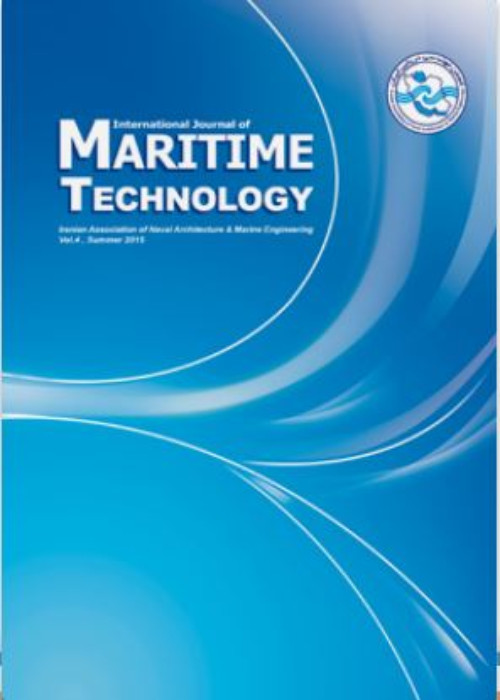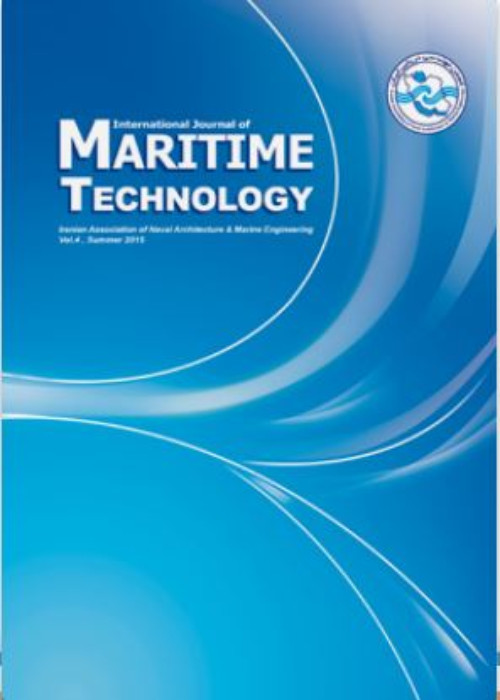فهرست مطالب

International Journal of Maritime Technology
Volume:10 Issue: 17, Autumn-Winter 2023
- تاریخ انتشار: 1401/12/13
- تعداد عناوین: 6
-
-
Pages 1-12
Considering the strategic importance of coastal areas from various aspects, their protection against waves is a coast management necessity. Since long ago, strong coastal structures have protected coasts, but since they disturb the coastal ecosystem balance, effort has been made to use them less or make them more compatible with the coast. This research is specifically aimed to estimate the efficiency of environment-based methods such as the combined tree planting-structural methods compared with merely structural methods, in damping the coastal waves and, hence, protecting the coasts. In this research, coastal dikes with 3 different height situated in 3 different locations in combination with 3 rows of tree under the influence of 5 wave heights are investigated. Experimental results showed that the highest wave damping (80%) occurs by positioning the structure in the beginning of the protected area, covered by trees at its tail. To check the force reduction rate, the most effective protection plan is when the structure is in the middle of the protected area and the tree cover lies in front as well as in the back of the structure. In this case, the wave force damping is 10.7 times the :case when: the coast has no obstacles; when there are no trees and the structure is alone, the wave force damping is more than 50%. This mode, compared to the best performance mode - the structure lies alone at the beginning of the protected area, has increased the wave force damping efficiency by about 14%.
Keywords: coastal dyke, wave damping, coast protection, tree cover, force absorption -
Pages 13-24
Catamaran added V-like center bow (INCAT) is investigated as a wave-piercing vessel to decrease vertical acceleration and diminish slam events during sea-keeping operation. The catamaran and the vessel bow were modeled and the vertical acceleration of model was validated with experimenal test. The geometry of V-like center-bow such as slope of center bow and elevation from demi-hulls was optimized numerically in the case of 3 different slops of bow model. Considering different center bow elevation of 9.5 and 49.5 mm, the pressure contour of the INCAT vessels was compared numerically. The optimized INCAT vessel as well as the catamaran vessel was fabricated and exposed experimentally in a wavy environment with two significant wave height of 11 and 17 cm using a towing tank test. Thus hydrodynamic parameters such as vertical acceleration, heave, pitch, and resistance force were measured and compared. The results show no slam event in the environment with a wave height of 11 cm but the slam event occurr at the experiment with the wave height of 17 cm.
Keywords: Catamaran, INCAT, V-like center bow, Vertical acceleration, slam -
Pages 25-48
Over the past two decades, maritime transportation and container traffic worldwide has experienced rapid and continuous growth. With the increase in maritime transportation volume, the issue of greenhouse gas (GHG) emission has become one of the new concerns for port managers. Port managers and government agencies for sustainable development of maritime transportation considered "green ports" to balance between environmental impacts and economic interests. Therefore, this study aims to integrate the Berth Allocation and Quay Crane Assignment Problem (BACAP) with speed optimization and vessels emission considerations. Rajaee port, the most important port in Iran, was selected as the case study. A mathematical model is developed based on the main characteristics of this port and is solved by GAMS IDE/CPLEX software. Given the NP-hard complexity of the BACAP, exact solution approaches need huge time, even for small and medium problems. Hence, an adapted Non-Dominated Sorting Genetic Algorithm-II (NSGA- II) and a Multi-Objective Simulated Annealing (MOSA) algorithm are adopted to deal with the complexity of the proposed model. Sensitivity analysis is used to assess the applicability of the proposed model and evaluate the efficiency of the solution algorithms.
Keywords: Container Terminals, Berth Allocation Problem, Quay Crane Assignment, Mathematical Modeling, Green Ports -
Pages 49-56
Gorgan Bay is one of the greatest economic and ecological areas in Iran and is used as a recreational and fishery center by the region's residents. This bay connects to the Caspian Sea through two channels, Ashuradeh and Chapoqli. The hydraulic connection of Gorgan Bay with the Caspian Sea greatly impacts water recirculation and aquatic life in this region. As a result, the decrease in the water level of the Caspian Sea, and the disruption of the hydraulic connection between them have caused problems with the water quality in the bay in recent years. Several solutions have been proposed to solve these problems, including dredging the Ashuradeh and Chapoqli channels, reopening the Khozeini channel, and transferring water by pipeline to the west of the bay. Although the mentioned actions can increase the volume of water exchanges and reduce water retention time, each action requires careful consideration to estimate its long-term effectiveness. Considering the possibility of re-sedimentation in each of the above channels, studying sedimentation and erosion patterns in this area can help determine the shape, depth, and duration of dredging and the economic justification of jetty construction at the channels’ mouth. Hence, in this study, the amount of sediment load beside the patterns of erosion and sedimentation after dredging the Khozeini channel as well as the effects of implementing jetties have been determined using Mike 21. Based on the simulation results, the area has an active sedimentary pattern that can impact the bed level inside the channel. These effects can be reduced at the channel’s mouth by constructing two jetties on its sides.
Keywords: Khozeini Channel, Sediment Transport Modeling, Gorgan Bay, Mike-21 -
Pages 57-64
This paper presents a new robust fin control method based on L2 gain design to reduce ship roll motion and waves disturbance effects. The process involves the nonlinear dynamics of the ship roll and its fin actuator. External disturbances of waves and model parameters variations are considered as process uncertainties. The state feedback controller is designed to reduce the effect of wave disturbance on the controllable variables of the process. For controller design, nonlinear H∞ approach has been employed in the sense that it ensures the stability of the process and achieves the desired control objectives. To solve the inequalities associated with the nonlinear H∞ problem, an efficient SOSTOOL-based algorithm is presented. Simulation results are presented to evaluate the efficiency of the proposed approach. In order to validate the proposed algorithm, it is compared with PID controller. Results show the superiority of the designed controller based on Robust Nonlinear H∞control over PID controller.
Keywords: ship roll, L, 2 gain, robust control, nonlinear H, ∞ control -
Pages 65-75
The effects of mooring system selection (turret and spread) are investigated on dynamic performance and fatigue life of steel catenary riser (SCR) and lazy-wave steel catenary riser (LWSCR) as two of the most conventionally used flexible risers. The fully coupled hull, mooring, and riser models are simulated by finite element method under the same environmental conditions and floater specification. It was demonstrated that the changes in the mooring system from turret to spread have more influence on SCR than LWSCR in terms of the displacement range of the TDP, dynamic response, and maximum von-misses stress. The fatigue results of the two types of risers are considerably affected by mooring systems selection. According to the results, it can be inferred that the use of the turret mooring system increases the fatigue life of SCR while in LWSCR, the spread mooring system improves fatigue life.
Keywords: Turret, spread mooring, Catenary riser, Lazy-wave, FPSO, Mooring-riser interaction


